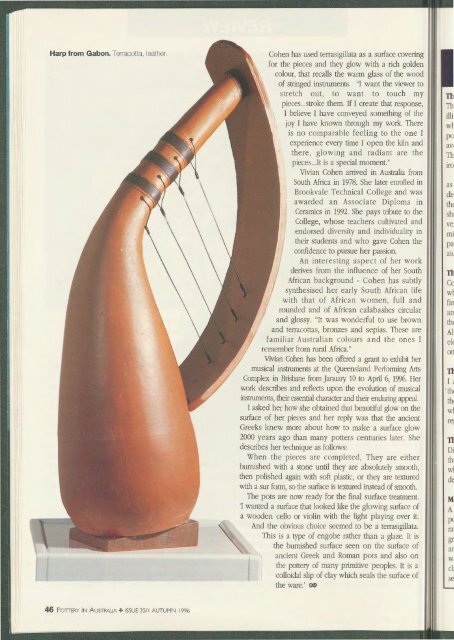Pottery In Australia Vol 35 No 1 Autumn 1996
Create successful ePaper yourself
Turn your PDF publications into a flip-book with our unique Google optimized e-Paper software.
Harp from Gabon. Terracotta, leather.<br />
Cohen has used terrasigillata as a surface covering<br />
for the pieces and they glow with a rich golden<br />
colour, that recalls the warm glass of the wood<br />
of stringed instruments. "I want the viewer to<br />
stretch out, to want to touch my<br />
pieces ... stroke them. If I create that response,<br />
I believe I have conveyed something of the<br />
joy I have known through my work. There<br />
is no comparable feeling to the one I<br />
experience every time I open the kiln and<br />
there, glowing and radiant are the<br />
pieces ... It is a special moment."<br />
Vivian Cohen arrived in <strong>Australia</strong> from<br />
South Africa in 1978. She later enrolled in<br />
Brookvale Technical College and was<br />
awarded an Associate Diploma in<br />
Ceramics in 1992. She pays tribute to the<br />
College, whose teachers cultivated and<br />
endorsed diversity and individuality in<br />
their students and who gave Cohen the<br />
confidence to pursue her passion.<br />
An interesting aspect of her work<br />
derives from the influence of her South<br />
African background - Cohen has subtly<br />
synthesised her early South African life<br />
with that of African women, full and<br />
rounded and of African calabashes circular<br />
and glossy. "It was wonderful to use brown<br />
and terracottas, bronzes and sepias. These are<br />
familiar <strong>Australia</strong>n colours and the ones I<br />
remember from rural Africa."<br />
Vivian Cohen has been offered a grant to exhibit her<br />
musical instruments at the Queensland Performing Arts<br />
Complex in Brisbane from January 10 to April 6, 19%. Her<br />
work describes and reflects upon the evolution of musical<br />
instruments, their essential character and their enduring appeal.<br />
I asked her how she obtained that beautiful glow on the<br />
surface of her pieces and her reply was that the ancient<br />
Greeks knew more about how to make a surface glow<br />
2000 years ago than many potters centuries later. She<br />
describes her technique as follows:<br />
When the pieces are completed, They are either<br />
burnished with a stone until they are absolutely smooth,<br />
then polished again with soft plastic, or they are textured<br />
with a sur form, so the surface is textured instead of smooth.<br />
The pots are now ready for the final surface treatment.<br />
'I wanted a surface that looked like the glowing smface of<br />
a wooden cello or violin with the light playing over it.<br />
And the obvious choice seemed to be a terrasigillata.<br />
This is a type of engobe rather than a glaze. It is<br />
the burnished surface seen on the surface of<br />
ancient Greek and Roman pots and also on<br />
the pottery of many primitive peoples. It is a<br />
colloidal slip of clay which seals the surface of<br />
the ware.' oo<br />
Tb<br />
Th<br />
illi<br />
w1<br />
po<br />
av,<br />
Th<br />
iro<br />
as<br />
di~<br />
th<<br />
sru<br />
ve<br />
mi<br />
pa<br />
aic<br />
Th<br />
Cc<br />
wl<br />
fin<br />
an<br />
th<<br />
Al<br />
el~<br />
on<br />
n<br />
I '<br />
th<<br />
th,<br />
wl<br />
re1<br />
TI<br />
Di<br />
th:<br />
wl<br />
de<br />
M,<br />
A<br />
pc<br />
ra1<br />
gr:<br />
an<br />
w:<br />
cl:<br />
se<br />
46 POTTERY IN AUSTRALIA + ISSUE <strong>35</strong>/ I AUTUMN <strong>1996</strong>

















